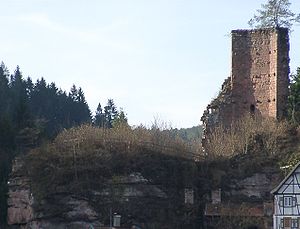
Elmstein Castle
Encyclopedia

High Middle Ages
The High Middle Ages was the period of European history around the 11th, 12th, and 13th centuries . The High Middle Ages were preceded by the Early Middle Ages and followed by the Late Middle Ages, which by convention end around 1500....
overlooking Elmstein
Elmstein
Elmstein is an Ortsgemeinde – a municipality belonging to a Verbandsgemeinde, a kind of collective municipality – in the Bad Dürkheim district in Rhineland-Palatinate, Germany.- Location :Elmstein lies in the Palatinate Forest...
in the Palatinate Forest in Rhineland-Palatinate
Rhineland-Palatinate
Rhineland-Palatinate is one of the 16 states of the Federal Republic of Germany. It has an area of and about four million inhabitants. The capital is Mainz. English speakers also commonly refer to the state by its German name, Rheinland-Pfalz ....
, Germany
Germany
Germany , officially the Federal Republic of Germany , is a federal parliamentary republic in Europe. The country consists of 16 states while the capital and largest city is Berlin. Germany covers an area of 357,021 km2 and has a largely temperate seasonal climate...
. It was built in the 12th century.
Location
The ruins are located on a 290 m high mountain on the northern side of the Speyer Brook Valley (German: Speyerbachtal) in the Palatinate Forest (German: Pfälzerwald).History
In the 12th and 13th centuries, the Elmstein Casstle was built as a PalatinePalatine
A palatine or palatinus is a high-level official attached to imperial or royal courts in Europe since Roman times...
castle in order to secure the route through the valley. The feoffee
Feoffee
A Feoffee is a trustee who holds a fief , that is to say an estate in land, for the use of a beneficial owner. The term is more fully stated as a feoffee to uses of the beneficial owner. The use of such trustees developed towards the end of the era of feudalism in the middle ages and became...
s held the title of the Schenk, a title of German aristocracy which translates roughly to servant. The castle occupied by the Electoral Palatinate. Between 1220 and 1230, the lower wall was built. Kaiser Louis IV
Louis IV, Holy Roman Emperor
Louis IV , called the Bavarian, of the house of Wittelsbach, was the King of Germany from 1314, the King of Italy from 1327 and the Holy Roman Emperor from 1328....
of Bavaria ceded the castle to his cousin, the Count Palatine
Count palatine
Count palatine is a high noble title, used to render several comital styles, in some cases also shortened to Palatine, which can have other meanings as well.-Comes palatinus:...
. From 1419 to 1437, the castle was occupied by Count Johann V. of Sponheim
County of Sponheim
The County of Sponheim was an independent territory in the Holy Roman Empire which lasted from the 11th century until the early 19th century...
. In 1466, the castle was mortgaged by Friedrich I the Elector
Frederick I, Elector Palatine
Frederick I, the Victorious was a Count Palatine of the Rhine and Elector Palatine from the House of Wittelsbach in 1451 - 1476....
, to Erhard of Remchingen. In 1513, because of the change the ownership situation, Heinrich of Pagk received the castle as a Fiefdom. During the Farmers War (1525) the castle was damaged. Count Palatine
Count palatine
Count palatine is a high noble title, used to render several comital styles, in some cases also shortened to Palatine, which can have other meanings as well.-Comes palatinus:...
Johann Casimir
Johann Casimir of Simmern
John Casimir of the Palatinate-Simmern was a German prince and a younger son of Elector Frederick III, Count Palatine of the Rhine. A firm Calvinist, he was a leader of mercenary troops in the religious wars of the time, including the Dutch Revolt...
inherited the castle in 1576. The castle was also damaged during the Thirty Years' War
Thirty Years' War
The Thirty Years' War was fought primarily in what is now Germany, and at various points involved most countries in Europe. It was one of the most destructive conflicts in European history....
(1648). In 1689 the castle came into its permanent state of disrepair during the War of Succession in Rhineland-Palatinate. Afterwards, the castle came into private ownership.
Literature
- Arndt Hartung, Walter Hartung: Pfälzer Burgenbrevier: Aufbaustudien. 6., erg. Aufl. Pfälzische Verlagsanstalt, Ludwigshafen 1985, ISBN 3-9801043-0-3.
- Walter Herrmann: Auf rotem Fels. Ein Führer zu den schönsten Burgen der Pfalz und des elsässischen Wasgau. Braun, Karlsruhe 2004, ISBN 3-7650-8286-4.
- Günter Stein: Burgen und Schlösser in der Pfalz. Weidlich, Frankfurt/Main 1976, ISBN 3-8035-8356-X.
- Alexander Thon (Hrsg.): Wie Schwalbennester an den Felsen geklebt. Burgen in der Nordpfalz. 1. Aufl. Schnell + Steiner, Regensburg 2005, S. 40–43, ISBN 3-7954-1674-4.
External links
- Rekonstruktionszeichnung by Wolfgang Braun

